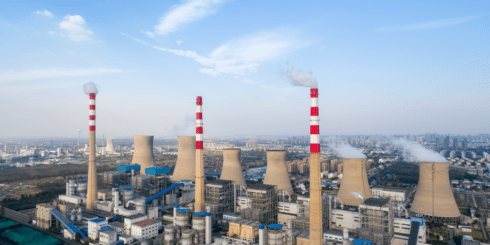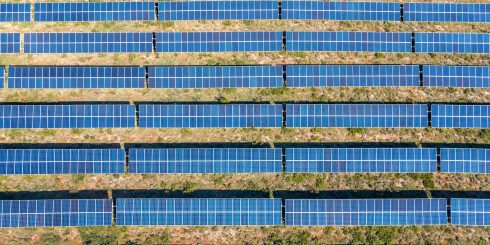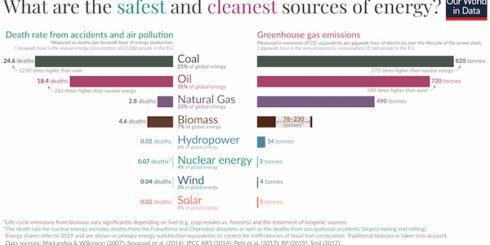In 2019 59 billion metric tons of carbon dioxide equivalent were released into the atmosphere, according to the UN Emissions Gap Report of 2020. These emissions, of course, are continuing to quickly change global climates.
Companies can save money in tax deductions and establish themselves as environmentally friendly leaders by switching to renewable energy and reducing carbon emissions.
Consequently, many in the power industry are now asking, “How can we reduce our carbon footprint to zero in power plants”?
More will need to consider how to reach a zero-carbon footprint in the near future, as renewable energy becomes imperative. After all, “the carbon footprint is currently 60 percent of humanity’s overall Ecological Footprint and its most rapidly growing component” according to Global Footprint Network.
Big brands such as Intuit, IBM, and a number of power plants have pledged to reduce and/or eliminate their carbon footprint in the coming years. These brands have their work cut out for them though, since switching to renewable energy is easier said than done.
However, Powerphase has a solution to help bring your power plant to have a zero carbon footprint. Keep reading to learn how to have a zero-carbon footprint with Powerphase in just 4 steps.
But first, let’s discuss what we do here at Powerphase and how exactly we are able to offer a solution of this nature.
How Does Powerphase Reach a Zero-Carbon Footprint in Power Plants?
Powerphase has an amazingly simple product that can maintain or increase your capacity by upgrading and converting your existing power plant to a zero-carbon power producer within your existing permits.
Powerphase is working with a leading gas turbine service supplier to provide 100% coverage of the upgraded gas turbine and BOP under an optional Long Term Service Agreement.
In California, Forested areas are monitored for winds, humidity, and temperature and PSPS (public safety power shut off) has been initiated. Hydro is down 1000MW, Diablo Canyon is scheduled to be decommissioned. Severe capacity shortages exist and new gas assets are not desirable, meaning it doesn’t align with Pathway 45. The drive for more renewables will only increase the demand for faster/low carbon firm capacity.
Powerphase has a near term simple step-by-step plant upgrade and conversion to get to 30% carbon footprint reduction and increase capacity with the introduction of Hydrogen and consuming 30% less H2 compared to a traditional CCGT.
The Problem:
On hot days when plants need the most output, the CCGTs are missing 10-20% of their mechanical/electrical potential output.
Here’s an illustrated example using a 7FA Combustion Turbine.

To solve this problem, let’s get right into the 4 steps to reduce carbon emissions and bring power plants to a zero-carbon footprint.
1. Add Electric Driven Turbophase™ to Your Combustion Engine
The first step to reducing carbon emissions is to add the electric driven Turbophase to your engine to add 6% incremental capacity offsetting less efficient peaking power Carbon Neutral
Turbophase can help reduce your engine’s carbon footprint by injecting compressed air into existing gas turbines for peaking capacities at combined cycle efficiency.
So what is Turbophase™?
Turbophase is a gas driven plant upgrade. It utilizes all the current plant capacity with gas powered air injection. It produces simple peaking power at combined cycle efficiency.
Variations of Turbophase can be added to a wide variety of turbines. Let’s look at some of the variations of Turbophase and compare the benefits of each. Each add-on will be tested on a 7FA Combustion Turbine in the following examples.
Results of Turbophase™ Gas Driven CCGT Plant Upgrade: 12% added power

Stats:
7FA Combustion Turbine with Turbophase:
- Energy Storage = 0 MW
- Capacity = 267 MW net (per 1×1 CCGT on a hot day)
- Incremental Plant Heat Rate with Turbophase= Baseline Inc GT Fuel / Net Output ~6400
- O&M = Incremental Maintenance/cost ~$1.0/MWh
Reference California 4×2 CCGT on a hot day = 1070MW (total net load of TPMs ~50MW):
- Air injection optimized to meet generator capacity
- Air heated with PPI’s proprietary patent pending technology
- 0.5 minute start up to full power – no maintenance penalty for starts
- PPI will integrate with the Global Service provider to integrate controls into model based Mark 6E for TPMs and maintaining TIT during injection
- Exhaust temperature dropped 25F eases HRSG concerns and would enable peak firing more often
- 6% carbon savings compared to generating additional energy with CCGT, 30% carbon savings compared to generating the same energy with SSGT
- More efficient than current duct burners
Results of Turbophase™ All Electric – No New Air Permit Required: 6% Power
Stats:

7FA Combustion Turbine with Turbophase:
- Energy Storage = 0 MW
- Capacity = 267 MW net (per 1×1 CCGT on a hot day)
- Incremental Plant Heat Rate with Turbophase= Baseline Inc GT Fuel / Net Output ~6400
- O&M = Incremental Maintenance/cost ~$1.0/MWh
Reference California 4×2 CCGT on a hot day = 1070MW (total net load of TPMs ~50MW):
- Air injection optimized to meet generator capacity
- Air heated with PPI’s proprietary patent pending technology
- 0.5 minute start up to full power – no maintenance penalty for starts
- PPI will integrate with the Global Service provider to integrate controls into model based Mark 6E for TPMs and maintaining TIT during injection
- Exhaust temperature dropped 25F eases HRSG concerns and would enable peak firing more often
- 6% carbon savings compared to generating additional energy with CCGT, 30% carbon savings compared to generating the same energy with SSGT
- More efficient than current duct burners
As you can see, both the electric and gas driven Turbophase plant upgrades provide significant benefits in the reduction of the overall carbon footprint.
Next, let’s look at how the Turbophase GSX™ can further assist in reducing the power plant’s overall carbon emissions, with additional energy storage.
2. Add Turbophase GSX (HP Compressors and Storage Tanks) to Increase Storage Capacity
Step two towards a zero-carbon footprint is to Add HP compressors and storage tanks to the step above.
You’ll get combined electric driven Turbophase plus with 6% capacity increase plus energy storage (Turbophase GSX) that can add a total of 12% capacity where the storage can be from a renewable energy resource providing ~6% carbon footprint reduction for incremental power, 0.4% plant reduction.
The Turbophase GSX also utilizes all the current plant capacity with gas powered air injection and uses simple peaking power at combined cycle efficiency (similar to the examples above).
However, the Turbophase GSX add-on provides the capability of additional energy storage.
In the following example on a 7FA Combustion Turbine with Turbophase GSX, you’ll see the capability of 120 MW of energy storage for 4 hours.
Turbophase GSX™ Off-Peak Renewables Converted to On-Peak Power
Stats:
7FA Combustion Turbine with Turbophase GSX:
- Energy Storage = 120 MW for 4 hours
- Capacity = 280 net (per 1×1 CCGT on a hot day)
- Incremental Plant Heat Rate with Turbophase GSX = Inc GT Fuel / Output ~3750
- O&M = Incremental Maintenance/cost ~$1.0/MWh
Reference California 4×2 CCGT on a hot day = 1120MW (total net load ~1MW when injecting):
- Air injection optimized to meet generator capacity
- Air heated with PPI’s proprietary patent pending technology
- 0.5 minute start up to full power – no maintenance penalty for starts
- PPI will integrate with the Global Service provider to integrate controls into model based Mark 6E to control BOP and maintain TIT during injection
- Exhaust temperature dropped 25F eases HRSG concerns and would enable peak firing more often
- 70MW continuous available with LP compressors running only (same as electric driven TPMs)
- 45% carbon savings compared to generating additional energy with CCGT, 60% carbon savings compared to generating the same energy with SSGT
The Turbophase GSX is a great way to reduce emissions and simultaneously store energy.
The next step to reducing carbon emissions is to repurpose these parts into the Fastlight Storage Engine™ (FSE).
3. Repurpose the Above Addons into Fastlight Storage Engine™ (FSE)
The next step is to repurpose 100% of the above add-ons and convert the CCGT to a Fastlight Storage Engine, repurposing the HRSG to a recuperator, and add 30% capacity with a 30% carbon footprint reduction.
Our FastLight Storage Engine is developed with grid-scale energy storage in mind. It’s an economical and eco-friendly technology supporting the widespread deployment of renewables worldwide.
Using established gas turbines, the FastLight Storage Engine stores renewable energy in the form of compressed air and provides firm, baseload renewable energy to the grid. When storage is depleted, the system also functions as an efficient peaker asset to deliver power as needed.
Fastlight Storage Engine™ (FSE) Conversion Provides Low Carbon & Low Risk Multiphase Approach to a Zero Carbon Future
Future
Turbophase GSX compression, storage, and HRSG can be repurposed, and additional identical compression and storage modules added to realize FSE conversion
Stats:
7FA Fastlight Storage Engine (FSE):
- Energy Storage = 400 MW for 4 to 18 hours
- Capacity = 400 MW net (per GT on any day) using stored air and 230MW net continuous mode with no stored air “Peaker Mode”
- Plant Heat Rate ~4800 (30% carbon footprint reduction compared to CCGT)
- O&M = (Similar to SCGT + FSE) ~$3/MWh
Reference California 4 FSE = 1600MW (60% increase relative to current hot day capacity):
- Generators increased to 400MW
- Air heated with GT exhaust
- 5 minute start up to full power with PPI’s heat up technology
- 400MW generator synced to grid 24/7 (Var support when not producing power)
- PPI will integrate with Global Service Supplier to provide FSE hardware conversion, integrate GT + BOP controls into model based Mark 6E
- 3 out of 4 GT converted to FSE would produce the same power as 4×2 CCGT, but not ambient temp sensitive
4. Convert The Combustion System of FSE for Increased Capacity
The final step is to convert the combustion system of FSE for increased capacity.
When Hydrogen conversions are available for 7FA, convert the combustion system of FSE resulting in 30% more capacity and zero carbon.
That’s it! With these 4 steps, you will be well on your way to reducing carbon emissions and having a zero-carbon footprint.
4 Steps to Reducing Carbon Emissions in Power plants
To recap, the 4 steps to achieve a Zero-Carbon Footprint in Power plants are as follows:
- Add Electric Driven Turbophase™ to Your Combustion Engine
- Add Turbophase GSX (HP Compressors and Storage Tanks) to Increase Storage Capacity
- Repurpose the Above Addons into Fastlight Storage Engine™ (FSE)
- Convert the Combustion System of FSE for Increased Capacity
Powerphase’s Vision for a “Zero Carbon Future” is a Simple and Economical approach. All components are off the shelf/modular and can be deployed quickly. All of our systems offer carbon reduction and consume zero water. Additionally, all compression systems generate potable water from the intercooling process of compression.
For more information about renewable energy, you can read our recent article about how peaking power can help California’s ongoing energy crisis.
If you have any questions regarding our technology here at Powerphase, we are always eager to help!



